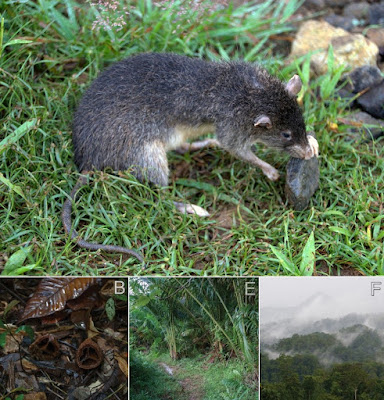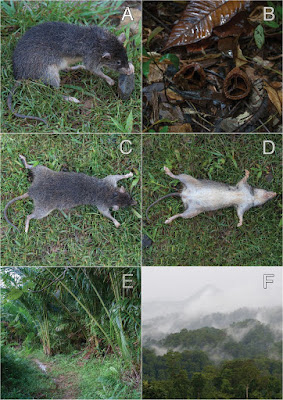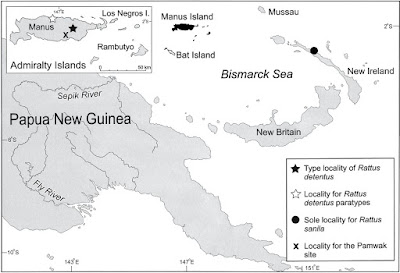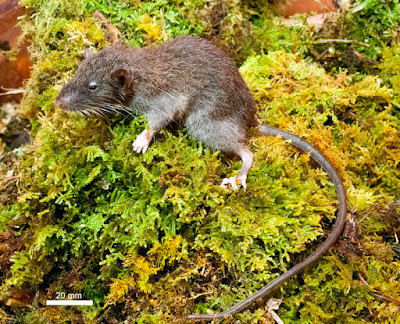[Most Recent Entries] [Calendar View]
Thursday, April 21st, 2016
| Time | Event | ||
| 1:11a | [Mammalogy • 2016] Rattus detentus • A New Species of Rattus (Rodentia: Muridae) from Manus Island, Papua New Guinea Abstract We describe a new species of Rattus, from 3 modern specimens collected on Manus Island in the Admiralty Group, Papua New Guinea, between 2002 and 2012. Subfossil specimens of early to late Holocene age from the Pamwak archaeological site on Manus Island are referred to the new species on morphological criteria; these confirm the species as a long-term resident of Manus Island. The new species is distinguished by its combination of large size; short tail; dorsal pelage that is coarse, spiny, and dark, with prominent black guard hairs; and sharply contrasting cream ventral pelage. Based on its overall body form, the species is almost certainly terrestrial. The dentition combines robust incisors with relatively small molars and the cranium displays a distinctive mélange of characters—including an elongate and anteriorly expanded rostrum and a mesopterygoid fossa that is narrow anteriorly and broadens to the rear. Sequence data from the mitochondrial control region and 3 nuclear genes place the new species as a highly divergent member of the Australo–Papuan Rattus radiation, with no identified close relative among sampled taxa. Morphological comparisons are made between the new species and other pertinent species of Rattus from the region, including R. sanila, a species known only from Late Pleistocene fossil to Late Holocene subfossil remains from an archaeological site on New Ireland. The conservation status of the new species is discussed in the light of a recent survey that failed to locate surviving populations in 2 areas of natural forest on Manus Island. Further survey work is urgently needed to identify any surviving populations and to assess the role of potential threats to the species. Key words: Admiralty Islands, Australo–Papuan Region, biogeography, Bismarck Archipelago, conservation, mitochondrial control region, molecular phylogeny, morphology, nuclear genes, Rattus sanila Rattus detentus, new species Timm, Weijola, Aplin, Flannery, and Pine Admiralties Rat syn: Rattus praetor: Williams 1999:244; not Mus praetor Thomas, 1888. Rattus mordax: Williams 1999:244; not Mus mordax Thomas, 1904a. Holotype. Adult female obtained by Valter Weijola on 24 August 2012. Voucher specimen fixed in formalin, preserved in spirit, and registered as PNGMAG 274363 (and AMS M45608) in the National Museum & Art Gallery, Port Moresby, Papua New Guinea (Figs. 1A, 1C, and 1D). Tissue sample preserved in ethanol and registered as ABTC 125036 in the Australian Biological Tissue Collection, South Australian Museum, Adelaide. Extracted skull is in excellent condition, all teeth fully erupted and moderately worn, cranium with advanced fusion of basicranial synchondroses (Fig. 2). Type locality. Vicinity of a small stream near western end of Kawaliap Village, el. 200 m (2°6′40″S, 147°3′40″E), Manus Island, Admiralty Islands, Manus Province, Papua New Guinea. Distribution. Currently known as a living animal from 2 localities on Manus and from subfossil remains from the Pamwak archaeological site (Fig. 3). Etymology. detentus (Latin for detained), in reference to the isolation of this Melanesian Rattus lineage on Manus Island and to the recent use of the island to detain people seeking political and/or economic asylum in Australia. Robert M. Timm, Valter Weijola, Ken P. Aplin, Stephen C. Donnellan, Tim F. Flannery, Vicki Thomson and Ronald H. Pine. 2016. A New Species of Rattus (Rodentia: Muridae) from Manus Island, Papua New Guinea. Journal of Mammalogy. DOI: 10.1093/JMammal/gyw034 | ||
| 9:54a | [Mammalogy • 2016] Gracilimus radix • A New Genus and Species of Omnivorous Rodent (Muridae: Murinae) from Sulawesi, nested within A Clade of Endemic Carnivores
Abstract We document a new genus and species of rodent (Muridae) from the west-central region of Sulawesi Island, Indonesia. The new taxon is known only from the type locality at around 1,600 m elevation on Mt. Gandangdewata of the Quarles Range, in the district of Mamasa. With phylogenetic analyses of DNA sequences from 5 unlinked loci, we infer that the new taxon is sister to the Sulawesi water rat, Waiomys mamasae, and nested within a clade of rodents from Sulawesi that otherwise feed exclusively on invertebrates. The new species is distinguishable from other rodents of Sulawesi by the combination of its small, slender body; soft, gray–brown fur; small, rounded ears; long, sparsely haired tail; long, fine mystacial vibrissae; gracile cranium; short rostrum; pronounced lacrimal bone; prominent, sickle-shaped coronoid process; and pale orange enamel on labial surface of incisors. Unlike its closest relatives, the new species feeds on both plant and animal matter, and may represent a rare evolutionary reversal of traits associated with a carnivorous diet in murids. Key words: biodiversity, Indonesia, molecular phylogeny, shrew rat, taxonomy, Wallacea Kevin C. Rowe, Anang S. Achmadi and Jacob A. Esselstyn. 2016. A New Genus and Species of Omnivorous Rodent (Muridae: Murinae) from Sulawesi, nested within A Clade of Endemic Carnivores. Journal of Mammalogy. DOI: 10.1093/JMammal/gyw029 Brand new mammal species joins the ranks of biology | SBS Science http://www.sbs.com.au/topics/science/nat Kami mendokumentasikan genus dan spesies hewan pengerat (Muridae) baru dari bagian tengah-barat Pulau Sulawesi, Indonesia. Takson baru ini hanya diketahui dari lokasi spesimen tipe pada ketinggian sekitar 1600 meter di Gunung Gandangdewata yang termasuk dalam rangkaian Pegunungan Quarlesi, Kabupaten Mamasa. Analisa filogenetik pada sekuen DNA dari 5 loci yang tidak terhubung menunjukkan bahwa takson baru ini merupakan kerabat dekat tikus air Sulawesi, Waiomys mamasae, dan berada pada kelompok hewan pengerat lainnya dari Sulawesi yang hanya memakan invertebrata. Spesies baru ini dibedakan dari hewan pengerat lainnya dari Sulawesi berdasarkan kombinasi beberapa karakter yaitu: tubuh ramping; rambut lembut abu-abu coklat; telinga kecil dan membulat; ekor panjang dan berambut jarang; kumis panjang dan tipis; tengkorak ramping; tulang hidung pendek; tulang lakrimal jelas; coronoid process tampak jelas dan berbentuk bulan sabit; dan enamel berwarna oranye muda pada penampang labial dari gigi seri. Tidak seperti kerabat terdekatnya, species baru ini memakan unsur tumbuhan maupun hewan, dan kemungkinan besar menunjukkan proses evolusi langka yang berbalik dari ciri yang diasosiasi dengan salah satu pemakan daging pada jenis Muridae. |
| << Previous Day |
2016/04/21 [Calendar] |
Next Day >> |









